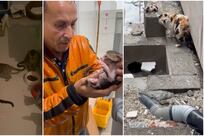Incredible footage that demonstrates both nature's awesome power and its vulnerability in the face of a changing climate has been captured by a researcher at New York University Abu Dhabi.
The time-lapse film shows a calving event in which a vast, 6.4-kilometre-long iceberg breaks free from the Helheim Glacier in eastern Greenland.
Denise Holland, the logistics co-ordinator for NYU Abu Dhabi's Centre for Global Sea Level Change and NYU's Environmental Fluid Dynamics Laboratory, shot the footage last month.
About half an hour of material is condensed into the 90-second clip, which shows a wide, flat tabular ice sheet break away from the glacier.
Thinner pinnacle icebergs also break off and turn over, and icebergs collide with
one another in the action-packed film.
"Science aside, it's an awesome natural event to witness," said Prof David Holland, the head of the Centre for Global Sea Level Change and Environmental Fluid Dynamics Laboratory.
“It’s spectacular, but [seeing it] there it’s 200 times more spectacular. The video doesn’t do it any justice.”
Although the video makes for incredible entertainment, it is also potentially important scientifically.
Gaining a better understanding of calving events is, the researchers say, useful for creating more accurate simulations of sea-level rise, because calvings contribute to such rises.
They are normal events, but they are believed to be contributing to the retreat of glaciers in Greenland and other parts of the world where ice is not being replaced as fast as it is being lost.
An increase in the rate of calving is one factor that has contributed to an overall decline in the scale of Greenland's ice sheet, which covers 1.8 million square kilometres – three quarters of the island – and is the world's only permanent ice sheet outside Antarctica. Prof Holland said concerns over the retreat of Greenland's ice date back to the 1990s.
“This video does not imply that climate change caused this event. It may have
some contribution to it or not,” he said.
Prof Holland said that while ice could be lost quickly from glaciers, replacing it was a slow process.
The video gives some indication, he said, of the complexity of calving – it shows numerous calving events and several types of iceberg. According to Prof Holland, there have not been many calving events monitored in detail with measurements being taken.
Most of the work of the research team working under Prof Holland is focused on the Thwaites Glacier, part of the Western Antarctic Ice Sheet.
However, Greenland is an easier location to make observations because it is not as difficult to travel to as Antarctica and there are numerous "outlet" glaciers. The Helheim Glacier is one of Greenland's largest outlet glaciers.
A scientific paper published in December by another group of researchers in Current Climate Change Reports said that calving and underwater melting at the edge of glaciers was responsible for between a third and half of the mass of ice discharged into oceans each year. The amount of ice being discharged is thought to be growing because of the warming of the oceans.
______________
Read more:
[ Want to know when the UAE summer will be over? Look to the stars ]
[ How climate change could send household bills soaring, with the Middle East at risk ]
Special report: Abu Dhabi's dwindling water reserves charted in worrying Sorbonne research
______________
In their paper, Glacier Calving in Greenland, the scientists said that better modelling was helping to improve the understanding of calving. They suggested that there was "some prospect of reaching the elusive goal of accurately predicting future tidewater glacier behaviour and associated rates of sea-level rise".
However, there are still many factors that remain imperfectly understood, and Prof Holland said that science was “nowhere near” having a complete model of how calving takes place.
Aside from calving, another key factor in the retreat of ice in Greenland is surface melting. Warmer weather is contributing to the growth of micro-organisms on the surface of the ice, which in turn causes it to absorb more sunlight and leads to more melting.
Reports indicate that from 1992 to 2011, glacial retreats in Greenland were responsible for a 0.74 millimetre annual rise in world sea levels.






